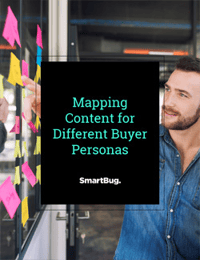SmartBug Media® Named 2024 HubSpot North American Partner of the Year. Learn More
-
HubSpot Services
HubSpot Onboarding
Centralize your teams, tools, and internal processes in a single platform engineered for enhanced collaboration.HubSpot Admin
Offload the busywork of backend operations management with a team of HubSpot experts to guide you at every turn.Marketing Hub
Generate qualified leads faster and leverage the full power of HubSpot’s AI-powered marketing software.Service Hub
Keep a pulse on your customers’ satisfaction with tools such as help desk, ticketing, and AI-powered support.Commerce Hub
Turn full carts into cash flow with easy-to-use e-commerce tools such as invoices, quotes, and revenue reporting.Integrations & Migrations
Upgrade your legacy software to systems that work the way you do with HubSpot’s fully integrated CRM.HubSpot Training
Deepen your understanding of HubSpot’s capabilities with hands-on training, available on-site and virtually.Breeze AI Onboarding
Stay ahead of the competition with AI solutions designed to accelerate productivity and streamline workflows.
-
AI & Tech ServicesPlatformsIndustries
-
Work & AwardsWork & AwardsRecent Case StudiesTechnology | Ashling PartnersHow We Used a Digital Overlay at an In-Person Event to Increase MQLs.Read the Case Study
-
AboutThe Company
-
ResourcesContent TypeIndustriesRecent ResourcesEvaluationEvaluation for Sales Leaders: HubSpot Sales Hub vs. SalesforceTake the 5-Minute Evaluation

Content Ideas for Every Stage of the Buyer’s Journey
February 12, 2020
Inbound marketing is about giving your prospects the right type of content at the right time. You have to give people exactly what they want when they want it—and we’re not talking about classic outbound content.
| Outbound methods: | Inbound methods: |
|
|
To build a library of compelling copy that converts, the inbound marketing approach focuses on creating content driven by buyer personas in order to hit the right notes at each stage of the Buyer’s Journey.
Whether your reader is in the awareness, consideration, or decision stage, there is something to move everyone through the buying journey. Let’s take a look at some ideas and examples for each stage of the Buyer’s Journey.
The Awareness Stage
At the awareness stage, a prospect is just starting to realize they have a problem. Content at this stage should be informative, help answer simple questions, and solve basic problems.
In addition to blog articles, e-books and infographics are great awareness stage content pieces because they can cover a general or broad topic in an easy-to-understand and visually compelling way. Think explanatory, 101-style content offers that use “how to” or “ultimate guide to” in the title.
E-Books and Guides
Long-form guides are a great way to provide tons of upfront value with zero sales pressure to a prospect while requiring very little commitment from them. You may also have some great blog articles on hand that you can easily parlay into an e-book. Here are some examples of e-books from some diverse industries:
- Banking: Introduction to Cash Recyclers: Who, What, Why
- Nonprofit: Food Dating Guide
- Healthcare: The Definitive Guide to the Costs of Plastic Surgery
- Senior living: The Benefits of Senior Living
- Manufacturing: The Essential Guide to Coil Thread Inserts Online

Infographics
Infographics are one of the best ways to take difficult, boring, or overwhelming topics and break them down in an easily digestible and interesting way. And, according to HubSpot, 32 percent of marketers believe visual images are the most important form of content for the business, and 51 percent are creating visual assets as part of their strategy. Although there are thousands of amazing infographic examples out there, we’re particularly fond of these:
- Your Complete Roadmap to Retirement
- The Ultimate Guide to Healthy Aging in Georgia
- In-House vs. Outsourced Sales Teams
- The Foundational Steps to Establishing a Tax Mobility Program
At the awareness stage, try to avoid talking about your company or product or service outright. Instead, only mention your company or solution in the final paragraph or call to action (CTA) because the prospect is just kicking off their problem-solving journey.
Remember: Although there’s no guarantee that someone reading your content at this stage will become a customer, the right content can display your industry expertise, which is the first step toward gaining trust and converting a prospect into a customer.
The Consideration Stage
At the consideration stage, your prospect has decided to find a solution for their problem and is now weighing their options. Consideration content should help the reader by explaining the available products, services, and solutions on the market. At this stage, think checklists, calculators, case studies, vendor comparisons, white papers, reports, and webinars.
Checklists
For leads in the process of making an important decision, checklists help with organization and planning—and they show them that you understand their challenges and are prepared to help solve them. There are a lot of different ways to write a checklist, from a quick, literal checklist to a mini guide with a checklist attached. Here are a few examples:
- The Ultimate Content Marketing Checklist for Senior Care Marketing Pros
- The Essential Technical SEO Checklist
- CRO's Checklist: Outsourcing Necropsy, Histology, & Pathology Services
Calculators
Calculators are a great consideration stage content offer because they’re interactive and can instantly provide personalized results that demonstrate your company’s value. Here are some examples of consideration stage calculators:
- Payment Plan Calculator
- HubSpot ROI Calculator
- Senior Living Cost Calculator
- Allbound Partner Relationship Management (PRM) Software ROI Calculator
Reports
A great way to help leads who are faced with multiple solutions to their problem is through a report, which also puts your company’s thought leadership and industry expertise on display. Companies with original research can get a lot of mileage out of reports—from email campaigns to infographics to blog articles. Here are a few examples:
- PROFIT MATTERS: U.S. Annual Hotel Performance Tracker 2019
- The 2019 State of Supplier Diversity Report—Supplier Diversity Programs
Consideration content engages more deeply with a lead and allows you to build trust and nurture the relationship. At the consideration stage, you want to help your lead determine whether your solution is the right solution for them—and you also need them to figure out whether you’re not the right solution for them.
The Decision Stage
Finally, once a lead reaches the decision stage, they’re ready to buy—they’re just investigating what it takes to become your customer. At this stage, the content takes a more direct approach with offers such as product spec sheets, competitor comparisons, case studies, fact sheets, and product implementation guides.
Demo opportunities and comparison charts can give a lead the last few bits of information they need in order to become a customer. Here are some different types of decision stage content:
- Vendor Comparison Chart
- Request a Demo landing page
- The Smart Safe Fact Sheet for Retail
- Decisions Days event agenda
At this stage, there are no restrictions about how frequently you mention your brand name, because the buyer knows who you are and is sold on your product. All you have to do is help them understand what happens after they sign on the dotted line.
Get Started with Inbound Marketing
No matter what industry you’re in, inbound marketing’s buyer-driven approach to content creation turns leads into customers by leveraging your company’s expertise and experience.
From research to strategy to execution, we can help you plan and execute a content marketing plan that reaches your customers wherever they are in their buying journey. Let’s talk.

About the author
Chaviva Gordon-Bennett was formerly a Senior Copywriter for SmartBug Media. She graduated from the University of Nebraska-Lincoln with a bachelor's degree in journalism. As a Senior Copywriter, Chaviva writes inbound marketing content for SmartBug's clients. Read more articles by Chaviva Gordon-Bennett.





